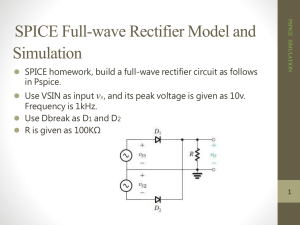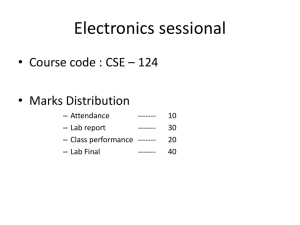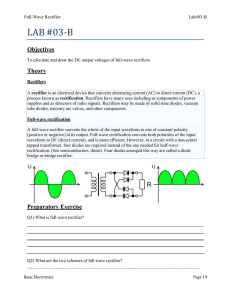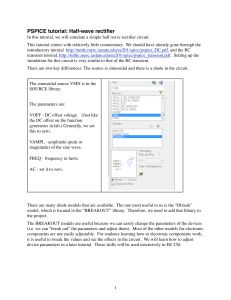DEFINITION: rectification is the conversion of alternating current (AC
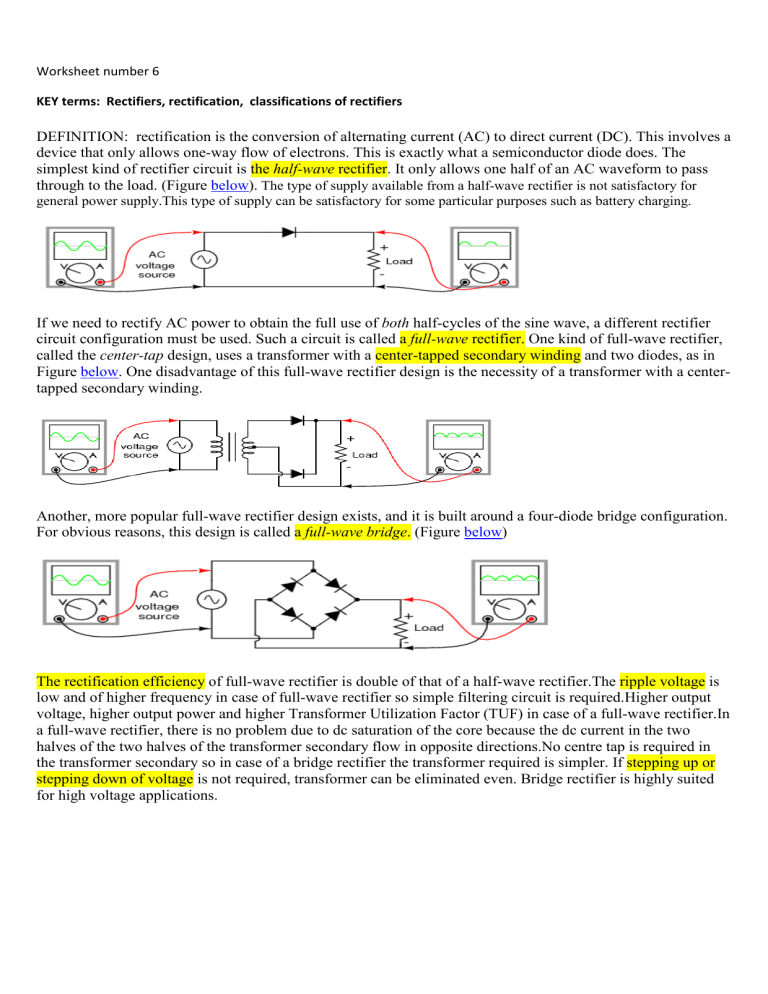
Worksheet number 6
KEY terms: Rectifiers, rectification, classifications of rectifiers
DEFINITION: rectification is the conversion of alternating current (AC) to direct current (DC). This involves a device that only allows one-way flow of electrons. This is exactly what a semiconductor diode does. The simplest kind of rectifier circuit is the half-wave rectifier. It only allows one half of an AC waveform to pass through to the load. (Figure below ).
The type of supply available from a half-wave rectifier is not satisfactory for general power supply.This type of supply can be satisfactory for some particular purposes such as battery charging.
If we need to rectify AC power to obtain the full use of both half-cycles of the sine wave, a different rectifier circuit configuration must be used. Such a circuit is called a full-wave rectifier. One kind of full-wave rectifier, called the center-tap design, uses a transformer with a center-tapped secondary winding and two diodes, as in
Figure below . One disadvantage of this full-wave rectifier design is the necessity of a transformer with a centertapped secondary winding.
Another, more popular full-wave rectifier design exists, and it is built around a four-diode bridge configuration.
For obvious reasons, this design is called a full-wave bridge. (Figure below )
The rectification efficiency of full-wave rectifier is double of that of a half-wave rectifier.The ripple voltage is low and of higher frequency in case of full-wave rectifier so simple filtering circuit is required.Higher output voltage, higher output power and higher Transformer Utilization Factor (TUF) in case of a full-wave rectifier.In a full-wave rectifier, there is no problem due to dc saturation of the core because the dc current in the two halves of the two halves of the transformer secondary flow in opposite directions.No centre tap is required in the transformer secondary so in case of a bridge rectifier the transformer required is simpler. If stepping up or stepping down of voltage is not required, transformer can be eliminated even. Bridge rectifier is highly suited for high voltage applications.
TASK:
A/ Find the statements which are not true:
1.
Half-wave rectifier is generally used for any kind of power supply.
2.
Usage of transformer with full-wave rectifier is optional.
3.
Bridge rectifier uses four diodes.
4.
If you want to increase voltage when using Bridge rectifier, it is not possible to eliminate the tarnsformer.
5.
It is widely common to use half-wave rectifier for battery charging.
B/ Watch the video and fill the missing expressions in the text:
1.
Full bridge rectifier is basically made up of………………………… …………………………in this arrangements.
2.
Generally, a single ………………. is used for low power rectification.
3.
A full bridge rectifier is used for high power rectification as well as reverse polarity………………………….
4.
If you want to work safely, you should …………………………your circuit properly and wear ………………………gloves.
5.
I can hardly feel it, DC is much less …………………………. ……………………… AC.
6.
Now I will measure some wave forms and I will turn my ………………………….. …………………….. on.
7.
On the scope you can see that the output voltage is around …………………. …………………………..
8.
Quick calculation shows having 170 volts across 100 OHM resistor generates ……………………… watts of power, it ´ s like having 300 watts lamp between your fingers.
9.
Remember, in such circuits,although unplugged,the …………………… hold charge for a long period of time.
C / Watch the video again and choose the best option:
1.
A diode can be compared to : a/el. check valve b/ water tap c/ electric pump
2.
10 A fuse is for: a/ protection b/ increasing current c/ increasing power
3.
Bridge rectifier can be found in: a/ microwave oven b/ every el. circuit c/ wallet
4.
By connecting the resitor: a/ circuit gets hot b/ output voltage drops c/ filtering rises
5.
Resistor is made up of: a/ copper wires b/ wires and ceramic core c/ ceramic core

